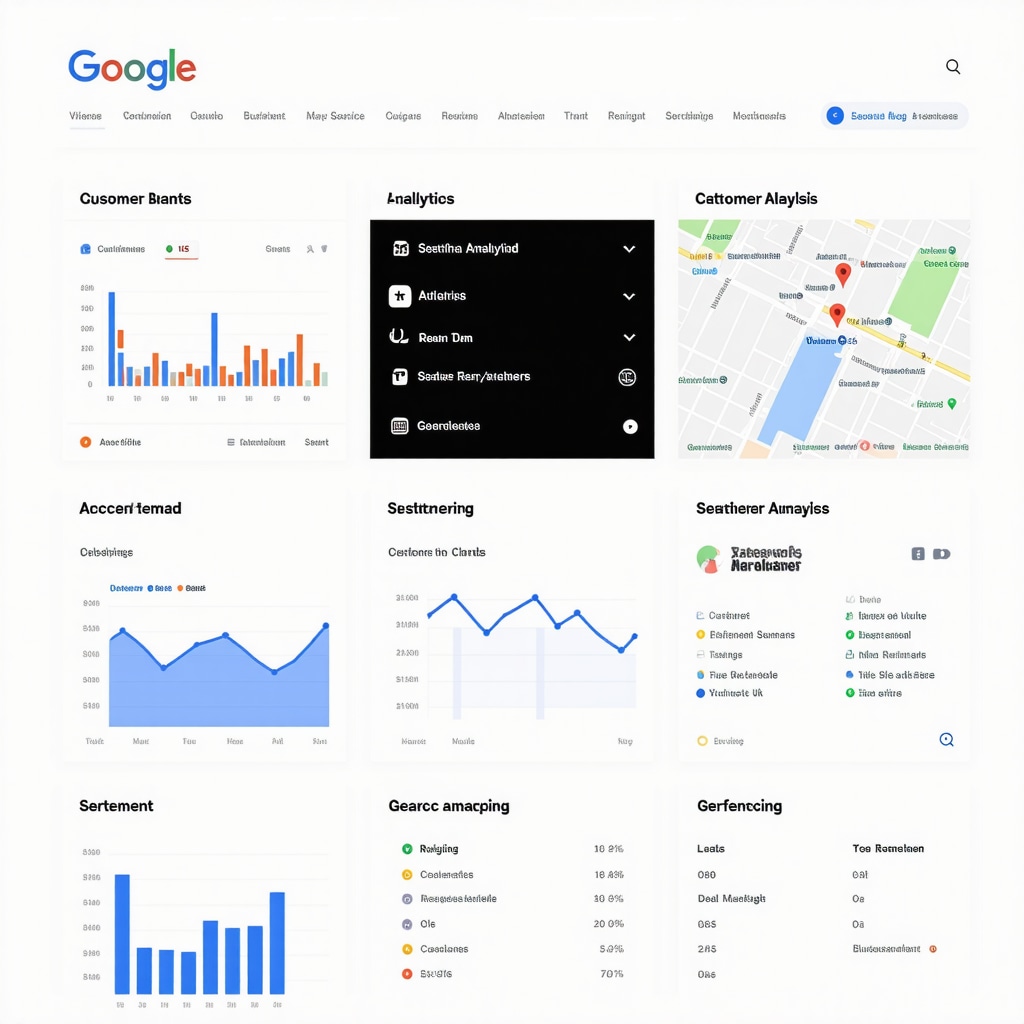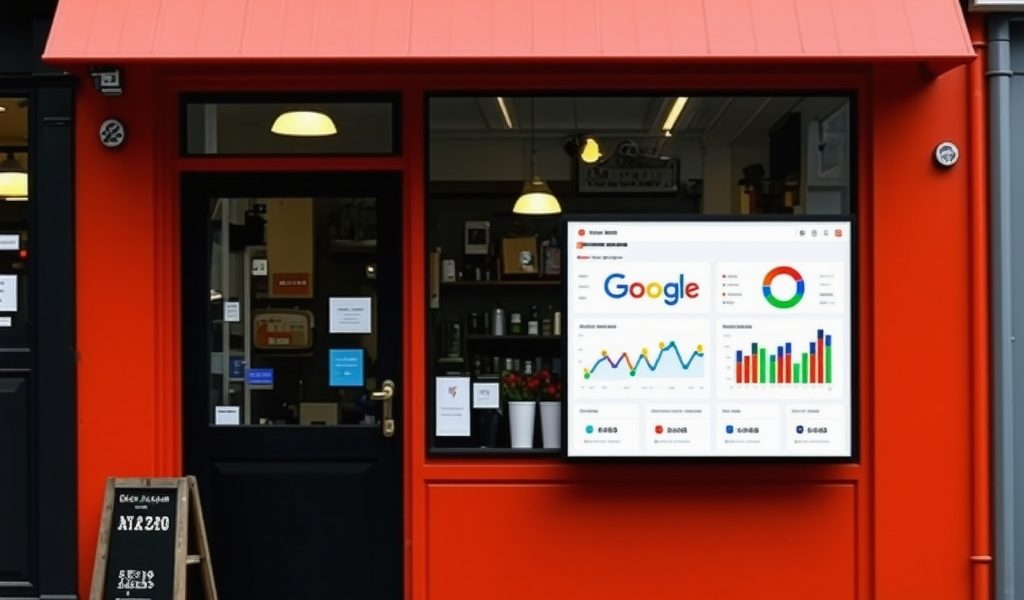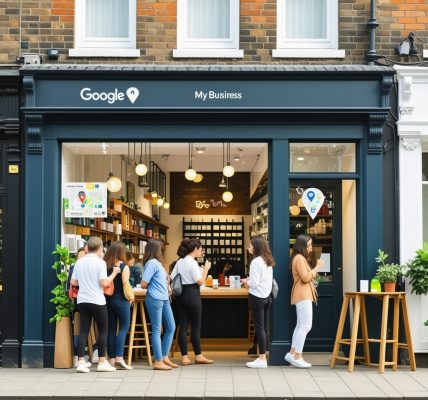Unlocking the Power of Google My Business Data for Local Expansion
In the fiercely competitive landscape of local commerce, leveraging data from Google My Business (GMB) has emerged as a vital catalyst for sustainable growth. Businesses no longer rely solely on traditional marketing — now, insightful analysis of GMB data empowers owners to make strategic decisions tailored to their local audience. By interpreting customer interactions, search queries, and engagement metrics, local businesses can optimize their visibility and customer outreach like never before.
Decoding Customer Behavior Through GMB Insights: A Strategic Approach
Google My Business provides a wealth of data points such as search terms, user actions (calls, direction requests, website visits), and peak engagement times. For example, a boutique café might discover that most customers find them via “best local espresso” searches and engage heavily between 8-10 AM. This insight enables the café to tailor their marketing messages, optimize posting times, and refine their service offerings to match customer demand patterns closely.
Furthermore, understanding the geographic distribution of searchers helps local businesses identify underserved neighborhoods or regions where promotional efforts could be intensified. This data-driven approach transforms vague assumptions into actionable strategies, maximizing ROI on marketing spend.
Elevating Local SEO with Targeted GMB Optimization Techniques
Applying advanced local SEO tactics using GMB data is essential for securing top rankings in Google’s Local Pack. This involves refining business categories, integrating high-conversion keywords naturally into business descriptions, and consistently managing citations across authoritative directories. Regular posting of relevant updates and promotions aligned with peak customer engagement times, as revealed by GMB analytics, boosts visibility and relevance.
One practical example is leveraging customer review insights to address common concerns or highlight popular products, thereby enhancing trust and click-through rates. A strategic focus on maintaining a robust review acquisition and management process can dramatically improve local search performance.
How Can Local Businesses Use GMB Data to Outperform Their Competitors?
To outperform, local businesses must adopt a continuous optimization mindset: regularly analyzing GMB reports to detect shifts in customer behavior or emerging search trends and adapting their profiles accordingly. Integrating GMB insights with other local SEO efforts, such as citation management and hyperlocal content marketing, creates a synergistic effect that elevates overall online presence.
Additionally, businesses should monitor competitor GMB profiles to benchmark performance and identify opportunities for differentiation. Tools like advanced GMB analytics enable this comparative analysis, driving informed, tactical decisions.
Embracing Expert Tools and Services for Accelerated Local SEO Growth
While in-house efforts are valuable, partnering with specialized services can amplify results. Expert citation management and curated local SEO strategies, such as those detailed in professional GMB citation services, ensure accuracy, consistency, and authority across platforms. This reduces the risk of ranking penalties and enhances credibility in Google’s local algorithm.
Moreover, tools that track GMB performance metrics in real time allow businesses to respond swiftly to customer trends and competitor moves, maintaining a dynamic and competitive local presence.
For further insights into optimizing your Google Business profile and unlocking local market potential, explore our comprehensive guides and expert tips to stay ahead in 2025 and beyond.
Feel inspired to transform your local business growth with data-driven GMB strategies? Share your experiences or questions below to join the conversation!
For authoritative insights on the impact of local SEO and Google My Business, consult resources like the Moz Local SEO Guide, a cornerstone reference for mastering local search dynamics.
Unlocking the Stories Behind Your GMB Reviews: A Goldmine of Customer Insights
From my experience helping local businesses optimize their Google My Business profiles, one aspect often overlooked is the treasure trove of information hidden in customer reviews. Beyond just star ratings, these reviews tell stories about what customers love, where improvements are needed, and even how your competitors are performing. For instance, I once worked with a small bakery where reviews frequently mentioned “friendly staff” and “fresh pastries.” This feedback helped them highlight these strengths in their business description and social posts, which boosted engagement significantly.
Conversely, addressing common concerns raised in reviews — like parking difficulties or slow service — showed potential customers that the business was attentive and committed to improvement. This proactive approach not only improved customer satisfaction but also positively influenced search rankings.
Integrating GMB Data with Other Local SEO Tactics: Building a Cohesive Strategy
Using GMB insights in isolation is helpful, but combining them with other local SEO strategies creates powerful synergy. For example, citation consistency across directories like Yelp, TripAdvisor, and local chambers of commerce reinforces business legitimacy. I’ve seen firsthand how consistent citations paired with optimized GMB profiles can propel businesses into Google’s coveted Local Pack.
Another tactic I’ve found invaluable is crafting hyperlocal content that reflects the community’s unique character. This kind of content, when aligned with GMB keywords and user search behavior, creates authentic connections with potential customers. Tools like BrightLocal and Moz’s Local SEO resources provide excellent frameworks for managing these multi-channel efforts effectively.
What Are Some Creative Ways to Use GMB Insights Beyond Basic Optimization?
Reflecting on my own journey, I often ask clients to think outside the box with their GMB data. For example, have you considered using peak engagement times to schedule local events or flash sales? One retailer I worked with noticed a spike in “near me” searches on weekends; they capitalized by running weekend-only promotions announced via GMB posts, which led to a noticeable traffic increase.
Additionally, analyzing search queries can inspire product or service expansions. A fitness studio found that many searches included “yoga for beginners,” prompting them to launch beginner-friendly classes that quickly filled up. These adaptive strategies take GMB optimization from a maintenance task to a dynamic growth driver.
Embracing Professional Support Without Losing Your Unique Business Voice
While I advocate for hands-on management of your GMB profile to maintain authenticity, partnering with specialized services can be a game changer. Expert citation management ensures your business data is accurate and authoritative across all platforms, as detailed in professional GMB citation services. This foundation supports all other SEO efforts by building trust with search engines.
Moreover, real-time tracking tools help you stay agile. I’ve seen businesses quickly adapt to emerging trends or competitor moves by monitoring their GMB performance metrics closely, a strategy that keeps them ahead in the local rankings race.
For those looking to dive deeper, exploring comprehensive guides like Mastering Google Business SEO can be invaluable for refining your approach.
Have you experimented with any unique GMB strategies or noticed interesting patterns in your local search data? I’d love to hear your stories or questions — feel free to share them in the comments below!
Harnessing GMB’s Advanced Analytics for Predictive Local Market Trends
Diving deeper into Google My Business’s extensive analytics capabilities reveals an underutilized goldmine for forecasting local market trends. Beyond surface-level metrics, businesses can analyze longitudinal data patterns—such as seasonal variations in search queries and user actions—to anticipate shifts in customer demand. For example, a landscaping company might observe spikes in “spring cleanup” searches starting in late February, enabling them to proactively tailor campaigns and resource allocation well ahead of competitors.
By integrating GMB insights with external data sources like local event calendars and weather patterns, businesses unlock multi-dimensional predictive models. This fusion empowers them to craft hyper-targeted marketing strategies that resonate precisely when and where customers are most receptive, ultimately securing a competitive edge in saturated local markets.
Leveraging Sentiment Analysis on GMB Reviews to Refine Customer Experience
While star ratings provide a quantitative snapshot of customer satisfaction, applying sentiment analysis techniques to review text uncovers nuanced feedback that can guide sophisticated service improvements. Natural Language Processing (NLP) tools can parse thousands of reviews, categorizing common themes such as product quality, staff demeanor, or ambiance with sentiment scores that track over time.
For instance, a boutique hotel may discover through sentiment trends that guests increasingly praise personalized staff interactions but express concerns about Wi-Fi reliability. This granular insight informs targeted operational adjustments that enhance guest satisfaction and foster positive word-of-mouth. Additionally, showcasing responsiveness to review feedback on the GMB profile itself signals attentiveness to prospective customers and bolsters trust.
How Can Businesses Integrate GMB Sentiment Data with CRM Systems for Enhanced Personalization?
Integrating sentiment-derived insights from GMB reviews directly into Customer Relationship Management (CRM) platforms creates a feedback loop that elevates personalization. By tagging individual customers’ preferences or pain points extracted from reviews, businesses can tailor communications, offers, and service encounters to align with each customer’s unique expectations. This approach not only deepens customer loyalty but also amplifies lifetime value.
Leading CRM solutions now offer APIs and plugins that facilitate automated ingestion of GMB review data, enabling real-time sentiment tracking and dynamic customer profiling. Businesses employing this integration report measurable improvements in campaign responsiveness and customer retention metrics.
Optimizing GMB Visual Content Strategy: Beyond Photos to Video and Virtual Tours
Visual content on GMB listings plays a pivotal role in capturing consumer attention and conveying brand personality. While high-quality photos remain foundational, incorporating video snippets and 360-degree virtual tours creates immersive experiences that differentiate businesses in local search results. Videos showcasing behind-the-scenes operations, product demonstrations, or customer testimonials can drive higher engagement rates and dwell times.
Furthermore, virtual tours offer an interactive window into the business environment, reducing uncertainty for potential customers and increasing foot traffic. Google has reported that listings with video content receive 35% more clicks to their websites than those without (Google Maps Blog, 2023).

Deploying Geo-Fenced GMB Campaigns for Micro-Targeted Outreach
Micro-targeting through geo-fencing leverages GMB data to trigger location-specific promotions or notifications within defined geographic perimeters. By combining GMB’s geographic search insights with mobile advertising technologies, businesses can engage consumers when they are physically near or within strategic zones.
For example, a retail chain could activate limited-time offers to users who frequently search for relevant products “near me” in a particular neighborhood. This precision marketing approach enhances conversion rates by delivering contextually relevant messages at moments of peak intent.
Implementing geo-fenced campaigns requires a robust understanding of local consumer movement patterns and regulatory compliance on data privacy, but the ROI potential is substantial for businesses aiming to dominate hyperlocal markets.
Are you ready to elevate your local SEO strategy with these advanced Google My Business techniques? Dive into our expert guides and join the community of savvy local marketers transforming their digital footprints.
Decoding the Synergistic Impact of GMB Data Fusion with AI-Driven Local Marketing
In the evolving realm of local search optimization, the convergence of Google My Business data with artificial intelligence technologies is redefining strategic decision-making. Businesses that harness AI-powered analytics to interpret GMB insights can uncover hidden patterns in consumer behavior, sentiment shifts, and geo-spatial trends with unprecedented granularity. This fusion enables predictive modeling that anticipates customer needs and optimizes resource allocation dynamically, offering a formidable advantage in crowded local markets.
For example, by feeding GMB engagement metrics and review sentiment into machine learning algorithms, a local restaurant chain can forecast demand surges, tailor menu promotions, and personalize customer outreach well before competitors react.
Innovative Approaches to Amplify Local Visibility through GMB Data Segmentation
Segmenting GMB data by demographics, device types, and time-of-day interactions allows marketers to create hyper-targeted campaigns that resonate deeply with specific audience slices. This granular segmentation surpasses generic targeting, facilitating tailored messaging that amplifies conversion potential.
Consider a fitness center that discovers higher mobile searches from millennials during early mornings and desktop searches from older demographics in the evenings. Such insights inform not only advertising schedules but also content style and promotional offers, maximizing engagement efficacy.
How Can Predictive Analytics Using GMB Data Transform Local Business Forecasting?
Predictive analytics leverages historical GMB data trends combined with external variables to generate actionable forecasts that guide inventory management, staffing, and marketing investments. By analyzing seasonal fluctuations, local event calendars, and competitor activity, businesses can model demand curves with considerable accuracy.
For instance, a garden supply store might use predictive models drawn from GMB search spikes around planting seasons to stock inventory optimally and time marketing pushes. According to a detailed study by Forbes Tech Council, companies employing such data-driven foresight report up to a 20% increase in operational efficiency and customer engagement.
Integrating GMB Data with Voice Search Trends for Future-Proof Local SEO
Voice search is rapidly altering how consumers seek local services, with conversational queries becoming the norm. Integrating GMB keyword insights with voice search analytics enables businesses to optimize their profiles for natural language queries and question-based searches.
Businesses that adapt their content and GMB Q&A sections to mirror voice search patterns capture a larger share of voice-driven traffic. For example, a plumbing service might optimize for queries like “who offers emergency pipe repair near me?” to appear prominently in voice assistant results.
Enhancing GMB Engagement with Interactive Features and Real-Time Updates
Beyond static information, leveraging GMB’s interactive capabilities such as messaging, booking integration, and real-time update posts significantly boosts customer interaction and satisfaction. Employing chatbots linked to GMB messaging can address inquiries instantly, improving conversion rates and reducing friction in customer journeys.
Moreover, timely updates about inventory, special offers, or unexpected closures communicated through GMB posts keep customers informed and engaged, fostering loyalty and trust.
Ready to propel your local business into the future with these avant-garde Google My Business strategies? Dive deeper into predictive analytics, voice search optimization, and interactive engagement by exploring our expert resources and join the forefront of local SEO innovation today!
Frequently Asked Questions (FAQ)
What specific GMB data points should local businesses monitor for maximum impact?
Local businesses should focus on metrics such as user search queries, customer actions (calls, direction requests, website visits), peak engagement times, and review sentiment trends. These data points reveal how customers discover and interact with the business, enabling tailored marketing and service adjustments.
How can sentiment analysis of GMB reviews improve customer experience?
Sentiment analysis uses Natural Language Processing to extract nuanced feedback from reviews beyond star ratings. This helps identify strengths and pain points, guiding targeted operational improvements and demonstrating responsiveness that enhances customer trust and loyalty.
Is it beneficial to integrate GMB data with CRM systems?
Yes, integrating GMB insights, especially sentiment data, into CRM platforms enables personalized communication and service tailored to customer preferences or concerns. This fosters deeper relationships, higher retention, and improved lifetime customer value.
What role do visuals like videos and virtual tours play in optimizing GMB profiles?
Beyond photos, videos and 360-degree virtual tours create immersive experiences that boost engagement and click-through rates. They provide authenticity and reduce uncertainty, positively influencing consumer decisions and increasing foot traffic.
How can geo-fenced campaigns enhance local marketing efforts using GMB data?
Geo-fencing targets consumers within precise geographic areas identified through GMB search patterns, delivering timely, relevant promotions. This micro-targeting increases conversion rates by engaging customers at peak intent moments near the business location.
What advantages does AI-driven analysis of GMB data offer?
AI-powered analytics uncover hidden trends and predictive insights from GMB data, enabling businesses to anticipate customer demand shifts, optimize resource allocation, and personalize marketing strategies, providing a competitive edge in local markets.
How does voice search integration impact GMB optimization?
Optimizing GMB content for natural language and question-based queries aligns with the rise of voice search, capturing more traffic from conversational searches and enhancing visibility in voice assistant results.
Can GMB data segmentation improve campaign targeting?
Segmenting GMB data by demographics, device types, and time segments allows creation of highly tailored marketing messages that resonate with specific audience groups, improving engagement and conversion outcomes.
How often should businesses update and optimize their GMB profiles?
Continuous optimization is key. Regularly analyzing GMB reports to detect behavioral shifts and emerging trends ensures that profiles remain relevant and competitive, leveraging new opportunities promptly.
Are professional citation services necessary for effective local SEO?
While not mandatory, expert citation management services ensure accuracy, consistency, and authority across directories, reducing ranking penalties and strengthening local SEO foundations efficiently.
Trusted External Sources
- Moz Local SEO Guide: A comprehensive resource offering foundational and advanced insights on local SEO best practices, citation management, and GMB optimization.
- Google Maps Blog (https://blog.google/products/maps/): Official updates and case studies from Google on features like immersive views and local business tools, providing authoritative data on GMB enhancements.
- Forbes Tech Council Articles on Predictive Analytics: Expert analyses on the application of predictive analytics in local business operations, offering strategic frameworks for data-driven forecasting.
- BrightLocal Research: Industry-leading studies and tools focused on local search marketing performance, including GMB data utilization and review management.
- Seminal Academic Papers on NLP and Sentiment Analysis: Research detailing methodologies for extracting actionable insights from customer feedback, underpinning advanced review analysis techniques.
Conclusion
Harnessing the full potential of Google My Business data equips local businesses with a powerful arsenal to dominate their markets. From detailed customer behavior insights to advanced predictive analytics and AI-powered sentiment evaluation, GMB offers multifaceted opportunities to refine marketing, enhance customer experience, and forecast trends with precision. Integrating these data-driven strategies with complementary local SEO tactics, visual content innovation, and interactive engagement mechanisms creates a cohesive approach that elevates visibility and drives sustainable growth.
Embracing continuous optimization and expert support ensures your business maintains a dynamic presence amid evolving consumer behaviors and competitive landscapes. By leveraging geo-fencing, voice search integration, and CRM connectivity, you can personalize outreach and maximize returns on your local marketing investments.
Ready to transform your local SEO strategy and unlock new growth avenues? Share your experiences, ask questions, or explore our advanced guides to stay at the forefront of Google My Business innovation and local market success.




I really appreciated the emphasis on using GMB reviews for insights into customer preferences. In my experience managing a local auto repair shop, digging into review sentiments helped us identify recurring issues like appointment delays and slow check-ins. Addressing these concerns publicly on GMB and improving our workflow not only boosted our ratings but also increased customer visits. What tools or methods have others found effective for automating sentiment analysis on reviews? I’ve seen some NLP tools that can greatly reduce the manual effort involved. Also, integrating GMB data with CRM systems sounds promising—has anyone tried this approach and seen notable results in personalized marketing? I believe combining data sources like this could really elevate local marketing efforts. Looking forward to hearing about different strategies from the community to maximize GMB insights!